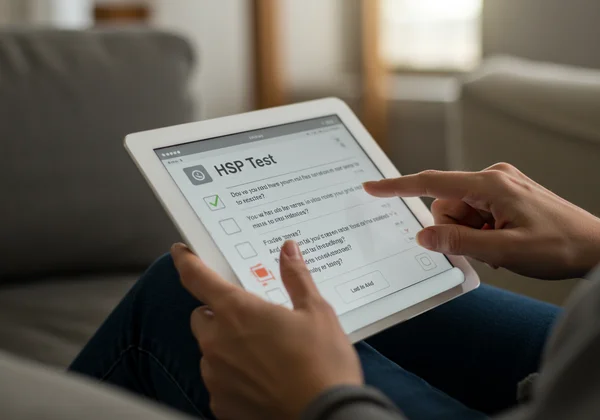Test HSP: Una Guida Professionale per Clienti e Studenti
Per i professionisti dedicati — terapisti, educatori, coach e specialisti delle risorse umane — comprendere le sensibilità uniche dei vostri clienti e studenti è di fondamentale importanza. Riconoscete i segnali sottili: il cliente che si sente profondamente sopraffatto dagli spazi affollati, lo studente che è profondamente influenzato dall'umore di un compagno, o il dipendente che prospera in ambienti tranquilli e concentrati ma fatica negli uffici open space. Questa guida illustra come un Test HSP scientificamente supportato possa servire come un valido strumento di screening preliminare, consentendovi di identificare, supportare e promuovere meglio la crescita negli individui altamente sensibili. Quali sono le caratteristiche di una persona altamente sensibile che potete imparare a individuare e supportare?
Questa guida vi guiderà nell'applicazione pratica della valutazione del tratto di Persona Altamente Sensibile (HSP). Sfruttando uno strumento affidabile come il test HSP gratuito, potete aprire una porta a una comprensione più profonda e a strategie più efficaci. Si tratta di passare dall'osservazione all'intuizione, e dall'intuizione a un supporto di impatto.
Comprendere il Tratto di Persona Altamente Sensibile (HSP)
Prima di utilizzare qualsiasi valutazione, è essenziale una conoscenza chiara e fondamentale del tratto stesso. L'alta sensibilità non è un disturbo o una debolezza; è un tratto temperamentale neutro e innato. Comprendere la sua base scientifica vi permette di discuterne con fiducia e precisione, fornendo un solido quadro per il vostro lavoro professionale.
Cos'è l'Alta Sensibilità (SPS)?
L'alta sensibilità, nota nella letteratura scientifica come Sensory Processing Sensitivity (SPS), è un tratto della personalità intrinseco caratterizzato da una maggiore profondità di elaborazione cognitiva e una maggiore reattività emotiva. Gli individui con questo tratto hanno un sistema nervoso più sensibile, il che significa che elaborano gli stimoli fisici, emotivi e sociali più profondamente rispetto agli altri. Questo può portare a notevoli punti di forza, come alti livelli di empatia, creatività e coscienziosità.
Tuttavia, può anche presentare sfide, come il diventare facilmente sovrastimolati o emotivamente esausti in ambienti molto esigenti. Riconoscere questi tratti HSP è il primo passo per aiutare i clienti e gli studenti a sfruttare i loro punti di forza e a gestire le loro sfide in modo efficace. L'obiettivo è fornire un vocabolario e un quadro che convalidi la loro esperienza.

La Scienza Dietro la HSP: La Ricerca della Dott.ssa Elaine Aron
Il concetto di Persona Altamente Sensibile è stato introdotto dalla psicologa clinica e ricercatrice Dott.ssa Elaine N. Aron negli anni '90. La sua vasta ricerca ha stabilito che le HSP costituiscono circa il 15-20% della popolazione, un tratto presente in oltre 100 specie, suggerendo che si tratta di una strategia evolutiva attentamente preservata. La Dott.ssa Aron ha sviluppato la Scala HSP, un questionario progettato per aiutare gli individui a identificare il tratto in se stessi.
La valutazione HSP si basa su questa ricerca fondamentale e peer-reviewed. Questo supporto scientifico è cruciale per i professionisti che richiedono strumenti affidabili e credibili. Quando utilizzate o raccomandate il test HSP di Elaine Aron, state connettendo i vostri clienti a un quadro costruito su decenni di studi psicologici, offrendo loro un punto di partenza affidabile per la scoperta di sé e ulteriori informazioni.

Utilizzare il Test HSP come Strumento di Screening Professionale
Integrare una valutazione HSP nella vostra pratica può essere un modo semplice ma profondo per migliorare i vostri servizi. Fornisce un metodo non invasivo e accessibile per raccogliere informazioni preliminari, avviare conversazioni e informare le vostre strategie di supporto fin dalle prime fasi.
Quando Considerare il Test HSP per Clienti o Studenti
Come professionisti, la vostra intuizione e le vostre osservazioni sono inestimabili. Potreste considerare di suggerire un test HSP in vari scenari:
- Per Terapisti/Coach: Un cliente descrive di sentirsi cronicamente sopraffatto, "troppo emotivo" o incompreso. Potrebbe lottare con il burnout, l'ansia o la difficoltà nel prendere decisioni a causa dell'elaborazione così profonda di ogni dettaglio.
- Per Educatori: Uno studente sembra facilmente turbato da aule rumorose, luci intense o pressioni sociali. Potrebbe essere molto intuitivo e creativo ma ritirarsi quando sovrastimolato.
- Per Specialisti delle Risorse Umane: Un dipendente mostra un'eccezionale concentrazione e qualità nel suo lavoro ma fatica con scadenze strette in un ambiente caotico o si sente svuotato da interazioni costanti con il team.
In questi casi, introdurre il concetto di HSP e uno strumento per esplorarlo può essere un'esperienza affermativa per l'individuo, fornendo un nome ai suoi sentimenti di una vita.
Come Usare la Piattaforma del Test HSP Online
Il processo di utilizzo del test HSP ufficiale è progettato per essere semplice e intuitivo sia per i professionisti che per gli individui che supportano. La piattaforma è costruita su un processo che dà priorità alla privacy. Gli utenti sono guidati attraverso una serie di domande attentamente formulate che riflettono le varie sfaccettature dell'alta sensibilità.
Al completamento, ricevono immediatamente un riepilogo gratuito e preliminare dei risultati. Questo feedback iniziale offre una panoramica del loro livello di sensibilità, fornendo una convalida immediata e una base per la discussione. L'intero processo è confidenziale, garantendo uno spazio sicuro per l'esplorazione senza impegno.

Interpretare i Risultati Preliminari e Approfondire le Intuizioni
Il riepilogo gratuito del test di personalità HSP conferma se le risposte dell'individuo si allineano con le caratteristiche di una HSP. Per molti, questa conferma da sola è un potente momento di auto-riconoscimento. Fornisce un linguaggio condiviso che potete usare per esplorare ulteriormente le loro esperienze.
Per coloro che cercano una comprensione più completa, la piattaforma offre un rapporto personalizzato opzionale, basato sull'IA. Questo rapporto va oltre un semplice punteggio, approfondendo un'analisi dettagliata del loro profilo unico. Evidenzia i punti di forza personali, le potenziali sfide e offre un piano d'azione su misura, rendendolo un'ottima risorsa da esaminare insieme in una sessione. Questo vi permette di co-creare strategie che sono veramente personalizzate in base alle loro esigenze.
Integrare le Intuizioni sulla HSP nella Vostra Pratica Professionale
Identificare il tratto HSP è solo l'inizio. Il vero valore risiede nell'utilizzare questa intuizione per personalizzare il vostro approccio, promuovere la resilienza e consentire agli individui di prosperare. Questa conoscenza può trasformare la vostra pratica professionale, rendendo i vostri interventi più precisi ed efficaci.
Discutere la HSP con Clienti e Studenti in Modo Costruttivo
Quando si discutono i risultati di un quiz HSP, è fondamentale mantenere un tono che sia di supporto e valorizzante. Inquadrate l'alta sensibilità come un tratto neutro con un insieme unico di vantaggi e sfide. Usate un linguaggio positivo e non giudicante.
- Concentrarsi sui Punti di Forza: Evidenziate gli aspetti positivi, come la creatività, l'empatia e il pensiero profondo.
- Normalizzare il Tratto: Ricordate loro che 1 persona su 5 condivide questo tratto; non sono soli.
- Convalidare le Loro Esperienze: Riconoscete come questo tratto possa spiegare sentimenti passati di sentirsi "diversi" o "troppo sensibili".
Questo approccio aiuta a costruire l'accettazione di sé e sposta l'attenzione dalla gestione di un problema alla coltivazione di una forza.
Differenziare la HSP da Altri Tratti: ADHD, Autismo, Introversione
Una domanda comune e cruciale per i professionisti è distinguere la HSP da altre condizioni. Sebbene possano esserci comportamenti sovrapposti, la neurobiologia sottostante differisce. La HSP è un sintomo dell'ADHD? No, la HSP riguarda la profondità di elaborazione, mentre l'ADHD è principalmente una difficoltà nella regolazione dell'attenzione.
La HSP è considerata autismo? Ancora una volta, no. Sebbene entrambi possano comportare sensibilità sensoriali, la HSP non è caratterizzata dalle sfide fondamentali nella comunicazione sociale associate al Disturbo dello Spettro Autistico (DSA). È anche distinta dall'introversione; mentre circa il 70% delle HSP sono introverse, il 30% sono estroverse. La chiarezza su queste distinzioni è essenziale per una guida accurata e per prevenire la falsa caratterizzazione. Potete sempre suggerire un test di elaborazione sensoriale per avviare la conversazione.
Personalizzare i Piani di Supporto per Individui Altamente Sensibili
Armati della conoscenza del tratto HSP di un cliente o di uno studente, potete creare piani di supporto altamente efficaci e personalizzati:
- Strategie Terapeutiche: Incorporate la mindfulness, esercizi di definizione dei confini e tecniche per gestire la sovrastimolazione. Aiutate i clienti a progettare stili di vita che rispettino il loro bisogno di tempo di recupero.
- Adattamenti Educativi: Suggerite semplici aggiustamenti come fornire un angolo tranquillo in classe, offrire cuffie con cancellazione del rumore o dare preavviso di cambiamenti alla routine.
- Adattamenti sul Luogo di Lavoro: Raccomandate orari di lavoro flessibili, opportunità per il lavoro profondo e canali di comunicazione chiari ed empatici per ridurre gli stressor ambientali e sociali.
Questi interventi mirati dimostrano che comprendete e rispettate veramente il loro temperamento innato.

Potenziate la Vostra Pratica con le Intuizioni sulla HSP
Comprendere l'alta sensibilità è una risorsa potente per qualsiasi professionista. Sfruttando questo test HSP completo come strumento di screening preliminare affidabile, potete sbloccare intuizioni più profonde, promuovere una maggiore comprensione e fornire un supporto più personalizzato ai vostri clienti e studenti altamente sensibili. Questa conoscenza non solo migliora i risultati; convalida le esperienze vissute dagli individui e li dota degli strumenti per la promozione di sé e una vita appagante.
Fate il primo passo verso il miglioramento della vostra pratica oggi stesso. Incoraggiate i vostri clienti o studenti a esplorare i loro tratti, o scoprite i vostri risultati per comprendere meglio questo affascinante aspetto della diversità umana. La vostra esperienza, combinata con questa potente intuizione, può fare la differenza.
Domande Frequenti per i Professionisti sul Test HSP
Questo Test HSP è uno strumento diagnostico clinico?
No, è fondamentale comprendere che il test HSP non è uno strumento diagnostico clinico e non dovrebbe essere utilizzato per diagnosticare alcuna condizione medica o psicologica. È uno strumento di auto-valutazione progettato per scopi educativi e di auto-consapevolezza. Serve come un eccellente strumento di screening preliminare per identificare i tratti associati all'alta sensibilità e per avviare una conversazione di supporto.
In Che Modo la HSP Differisce da Condizioni Come l'ADHD o il Disturbo dello Spettro Autistico?
Sebbene possano esserci sintomi sovrapposti come le sensibilità sensoriali, la natura fondamentale di questi tratti è diversa. La HSP è un tratto della personalità innato incentrato sull'elaborazione profonda degli stimoli. L'ADHD è una condizione neurosviluppo che influisce principalmente sulle funzioni esecutive come l'attenzione e il controllo degli impulsi. Il Disturbo dello Spettro Autistico implica sfide persistenti nella comunicazione e interazione sociale, insieme a comportamenti ristretti o ripetitivi. Un individuo può essere una HSP e avere anche l'ADHD o essere nello spettro autistico, ma sono concetti distinti.
Quali sono i benefici dell'identificazione dell'alta sensibilità nei miei clienti o studenti?
Identificare l'alta sensibilità può essere trasformativo. I principali benefici includono fornire una profonda convalida delle esperienze dell'individuo, ridurre l'auto-colpevolizzazione e promuovere l'accettazione di sé. Vi permette di sviluppare strategie di supporto altamente personalizzate ed efficaci, migliorare la comunicazione e consentire loro di sfruttare i loro punti di forza HSP, come l'empatia e la creatività, gestendo al contempo sfide come la sovrastimolazione.
Posso raccomandare questa risorsa ai miei clienti/studenti?
Assolutamente. Potete tranquillamente raccomandare questo test come risorsa affidabile e basata sulla ricerca. La piattaforma è gratuita, accessibile in oltre 15 lingue e dà priorità alla privacy dell'utente. Raccomandarlo fornisce ai vostri clienti e studenti un primo passo sicuro e di supporto verso la comprensione di una parte fondamentale della loro identità.